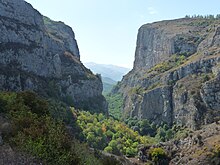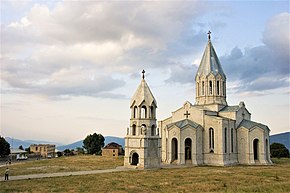| WARNING: A ceasefire agreement in Karabakh is in effect, but you should exercise extreme caution while in this region. Some parts of the region are closed to foreign visitors. Other civilian areas and may contain unexploded ordnance (UXO) and landmines. Many governments advise against all travel to Karabakh and the military-occupied area surrounding it, within 5 km of the Line of Contact, and within 5 km of the border with Armenia. For more information, see war zone safety. | |
Government travel advisories
| |
| (Information last updated 10 Dec 2023) |
Karabakh is a region in Azerbaijan. It was partly controlled by the de facto independent Republic of Artsakh from 1991 to 2023, when a military offensive returned it to Azerbaijani control.
Cities
[edit]As of October 2023, all cities of the region are heavily depopulated, although the Azerbaijani government plans to use them to re-settle refugees of the First Nagorno-Karabakh War and other Azeris.
- 1 Stepanakert (Khankendi) – The former capital of Artsakh is a small city and your likely base for exploring the region
- 2 Martakert (Aghdara) – The administrative center of Martakert Province with the Sarsang Reservoir
- 3 Martuni (Khojavend) – A small town near the small historically important Amaras Monastery; the city became a frontline city during the latter stages of the Nagorno-Karabakh War but also contains number of tombs from the Neolithic and Bronze Ages, several ruined medieval churches and remains of settlements and khachkars.
- 4 Hadrut – A small southern town with several nearby 13th- and 14th-century monasteries, and the terminus of the Janapar Trail.
- 5 Kalbajar – The administrative center of the Kalbajar District
- 6 Shusha – The historic capital of Karabakh that used to be one of the cultural capitals of the Caucasus
- 7 Agdam – A ghost town since the First Nagorno-Karabakh War in the early 1990s.
- 8 Vank – A small town close to the monastery of Gandzasar, one of Karabakh's top attractions. Also known for a hotel in the shape of a boat with a zoo, and the wall of license plates.
Understand
[edit]
Political status
[edit]Politically, Nagorno-Karabakh is a part of Azerbaijan, but had an ethnic Armenian majority since the days of the Russian Empire. As the Soviet Union was falling apart in the 1980s and 1990s, the ethnic Armenians in Nagorno-Karabakh decided to secede from Azerbaijan and join Armenia, resulting in the First Nagorno-Karabakh War being fought from 1988-1994, in which the local Azeris were ethnically cleansed from the area.
Although no country formally recognised Nagorno-Karabakh's independence, its de facto independence was maintained through economic and military support from Armenia. Azerbaijan, on the other hand, continued to assert its sovereignty over the region.
Nagorno-Karabakh was in a state of political limbo from 1994, when it declared independence, until 2020 when Azerbaijan regained much of its territory. It is recognized as part of Azerbaijan by all UN member states and was recognized only by three other self-proclaimed and unrecognized states: Transnistria, Abkhazia, and South Ossetia. After the Azerbaijani victory in 2023, the Republic of Artsakh was officially dissolved on 1 January 2024.
Background
[edit]
In 1920, Soviet Russia's Red Army occupied the Caucasus, leading to the formation of Armenia's and Azerbaijan's Soviet Socialist Republics (SSRs). The region of Karabakh, historically linked to both Armenian and Azeri ethnic groups, quickly became hotly-contested between these SSRs. In the end, the Soviet government opted to assign the region to Azerbaijan SSR, while keeping part of it, the Nagorno-Karabakh Autonomous Oblast, as an Armenian-majority autonomous region, but with a long-established Azeri minority.
By the late 1980s, the Soviet Union was in process of decline, with growing tensions between Armenia SSR and Azerbaijan SSR due to the dispute of the Nagorno-Karabakh region. After the dissolution of the USSR in the early 1990s, the situation finally escalated in 1992, when the Nagorno-Karabakh Autonomous Oblast declared itself independent from Azerbaijan, immediately getting support from Armenia. This led to a war of independence, and the area was ethnically cleansed of its Azeri population.
The fighting stopped with the 1994 ceasefire and the dispute moved from the theatre of war to diplomatic circles (the OSCE Minsk Group), where the region is still squabbled over by Armenia and its ally Russia, and Azerbaijan and its ally Turkey.
Fighting erupted again in September–November 2020, ending with a ceasefire agreement brokered by Russia that returned control to Azerbaijan areas inside and outside of Nagorno-Karabakh that had been occupied by Armenian forces and deployed Russian troops to the remaining Armenian-controlled areas for peacekeeping duties. In 2023, a new Azerbaijani offensive resulted in the surrender of the rebels, and the area has been incorporated into Azerbaijan.
Culture
[edit]During the First Nagorno-Karabakh War, the Azeri population was ethnically cleansed from the area. The region was culturally a part of Armenia until the Azerbaijani victory of 2023. Following the Azerbaijani victory, the Armenian population has fled to Armenia, and the region is expected to be re-populated with ethnic Azeris.
Geography
[edit]Nagorno-Karabakh is a landlocked region in the South Caucasus, lying between Lower Karabakh and Zangezur and covering the southeastern range of the Lesser Caucasus mountains. It is mostly mountainous and forested.
Get in
[edit]Get around
[edit]See
[edit]

Important tourist attractions inside of the main two cities include:
- Stepanakert, the capital city
- Shuka (Farmers market)
- Tatik Papik aka We Are Our Mountains (famous monument on northern outskirts)
Furthermore, many monasteries and other attractions can be found:
- 1 Gandzasar monastery. A main tourist attraction, literally meaning "treasure mountain". The fortified monastery has extensive carvings in the stone, beautiful architecture and sweeping views.
- 2 Dadivank monastery. Extensive monastery complex with red hues, a pair of covered impressive "lacework" khachkars and remnants of frescoes. It's undergoing a slow restoration and has a rich history to share.
- 3 Amaras monastery. A simple basilica church with surrounding serf walls. Rebuilt many times over the years, it has a very long and rich history.
- 4 Yeghish Arakyal monastery. A somewhat simpler version of Dadivank, in the hard to access far north of Artsakh. The complex has few visitors and is overgrown with vegetation in the lush forest it is found in.
- 5 Yerits Mankants monastery (Yeritsmankants). This beautiful remote monastery in an incredibly stunning river canyon is rarely visited, as military permission and a military escort are needed to reach this place.
- 6 Askeran fortress (Mayraberd). 10th–18th centuries. Served as the primary bulwark against Turko-nomadic incursions from the eastern steppe. The fort is found to the northeast of the region's capital city of Stepanakert in Askeran, and once extended across the entire river valley.
- In Shusha:
- Ghazanchetsots Cathedral of the Holy Savior
- City walls
- Govharagha Mosque
- Jtrtuz overlook of Karkar Canyon
- Zontik Waterfall (1½-hour hike on Janapar Trail)
- 7 Gtichavank monastery. A beautiful monastery on the iconic Togh mountain that is undergoing a slow restoration. At the foot of the mountain is Togh village with vineyards and a winery.
- 8 (Dzidzernavank). Ancient restored basilica with belfry on a rise in a picturesque river valley.
- 9 Tigranakert of Artsakh. The ancient city of Tigranakert, one of four cities that were founded in the 1st century BCE in opposite corners of Armenia and named after King Tigran II the Great, ruler of the short-lived Armenian Empire. Tigranakert has been undergoing archaeological excavations since 2005.
Do
[edit]
- 1 Qamışlı Gorge. A beautiful and impressively deep and steep gorge created by the river and possibly work for the road leading up north to Qamışlı village.
- Janapar Trail – One way to see much of Karabakh is simply to walk from one end to the other on this picturesque hiking trail. There is a marked trail which is broken up into day hikes which extend for 2 weeks of hiking. There are side trails and alternative routes as well. Trails take you to ancient monasteries and fortresses, through forests and valleys, to hot springs and villages. Each night you can either stay with a village family or camp out.
Eat
[edit]Drink
[edit]Stay safe
[edit]Drink bottled water if you are not accustomed to the local water. However if you are hiking, drinking water in mountain streams and ponds in reasonably safe, as long as you are sure it is not downstream from a large town (in which case it is likely contaminated with chemicals, street runoff, and/or waste.
This is a rural region: in the event of a medical emergency the hospitals in Nagorno-Karabakh are no more than a modest clinic. It is best to have with you a small first aid kit with bandaids, bandages, anti-biotic cream, ibuprofen, and any other medicine you may need.


